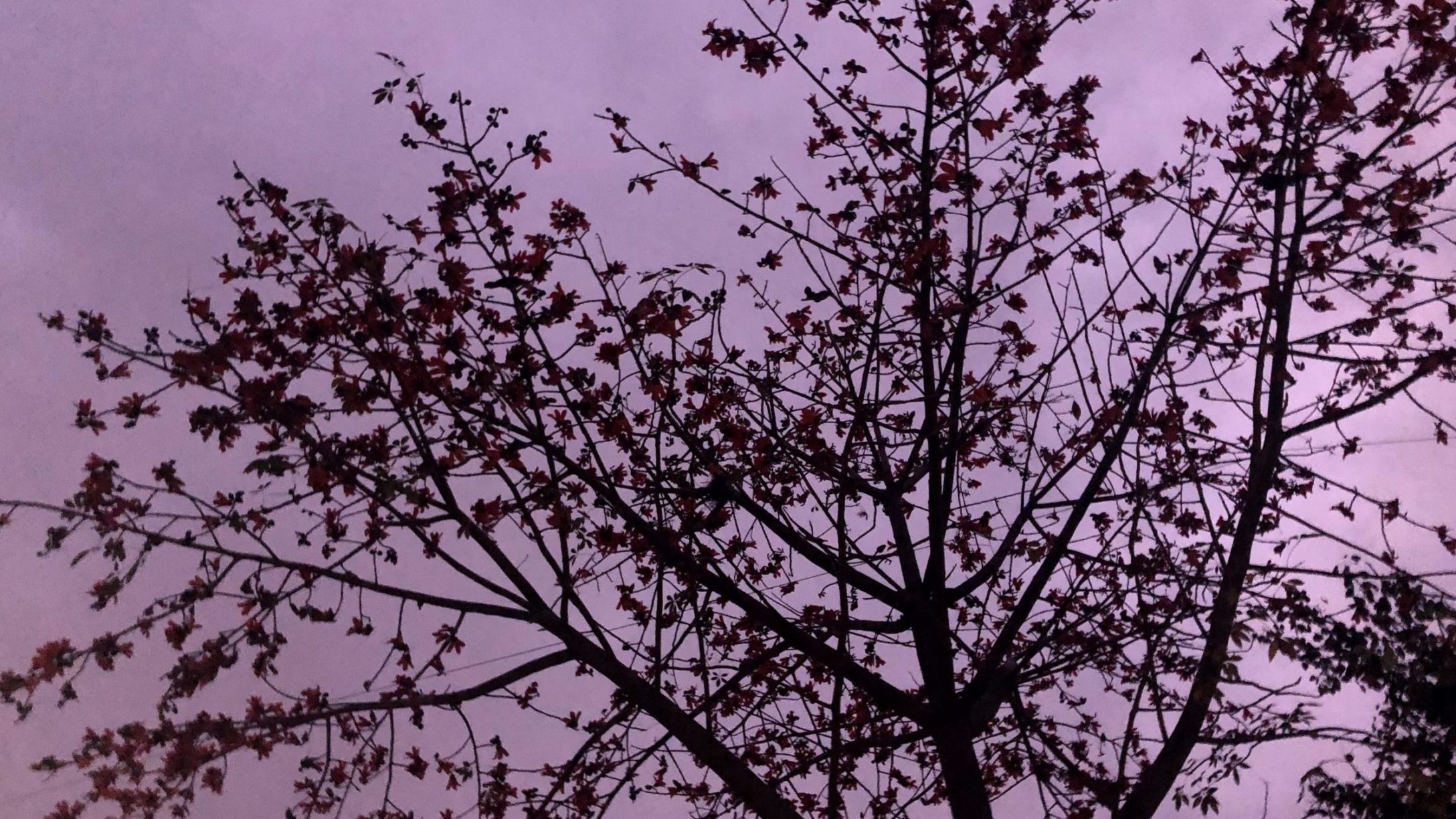In 2017, one quiet August night as I spoke with my mom on the phone, I went out for a walk. As we talked, I wandered through broad, tree-lined lanes with luxury cars parked on both sides, trying to recognize houses from TV shows. Our conversation tiptoed around the question of whether the new place I had rented was safe or not. I had to pacify her repeatedly, insisting that it was, though I had no inkling then what it meant to have a “safe” place in Delhi.
When I returned home, one of my flatmates looked up from her book and asked where I’d been. On a walk, I said. And she promptly warned me: “This is Delhi, don’t venture out of the house after 8-9pm.” Unfazed as I was then, I would soon wrap my whole existence around that advice. The safest-seeming places can be an open invitation to trouble here at any time of the day. Three and a half years and one lockdown later in this city, I am still trying to unlock these mysteries, while trying to negotiate a life of my own.
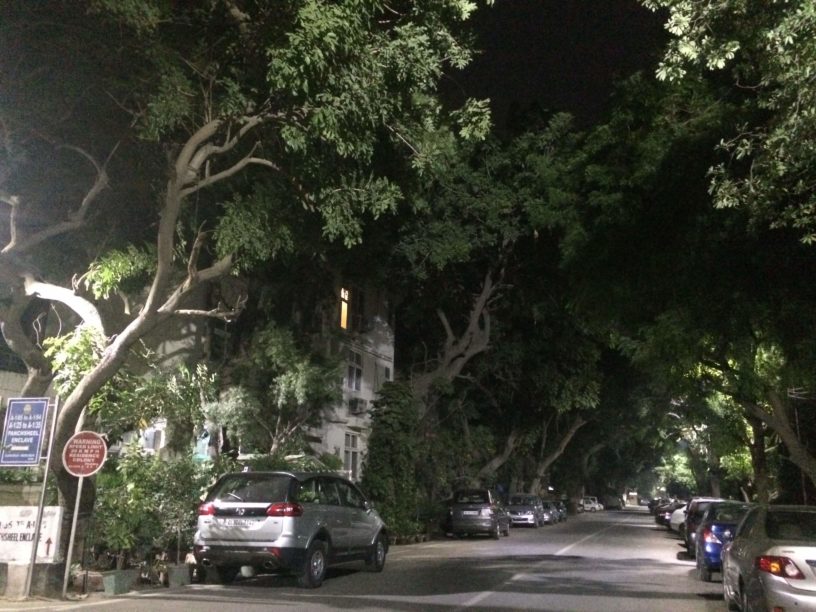
Growing up 410 kilometers to the east of Delhi, in the former industrial city of Kanpur, I would visit the capital quite frequently, staying with cousins and relatives who saw the city through clean, posh, urbane, upper middle-class eyes. I hated it then: busy, stuffy, too full of people who were too full of themselves. I wanted a more sparse, cool, quiet place to live.
But at 27, I fell into a job in the city, and just as the cliché goes, I found myself unable to leave. I found love and friends here, and a new life, food, spaces, even a different kind of writing.
My first place was in the well-to-do south Delhi pocket of Panchsheel Enclave. While I lived in this very upmarket and comfortable, if mildew-smelling, DDA-built flat (Delhi Development Authority) I was often dangerously alone while walking on the roads. The grandeur of the kothis (villas) and their majestic vistas in this part of the city were mesmerizing. But the people who lived in them were all too posh, never outdoors, stepping out only to commute from point A to B in their luxurious cars. There was a certain emptiness, sterility and callousness to this community.
As a woman renting a three-bedroom duplex with two other women in a neighborhood that otherwise only housed “families”, I would often encounter prejudice. All three of us were women in our late twenties, and by the rules of this society we were inconsequential, just women with little or nothing going on in our lives. That we all held jobs and pursued our respective passions meant nothing to anyone until we were married. Whenever I gave my clothes for ironing to the lady at the stall, she’d scowl and tell me that she was busy for the next three days. Uber drivers would be misdirected or ignored by the neighborhood guards. This kind of subtle ostracism laced my time there, forcing me to think twice before even doing the most mundane things like running an errand or stepping out for a walk.
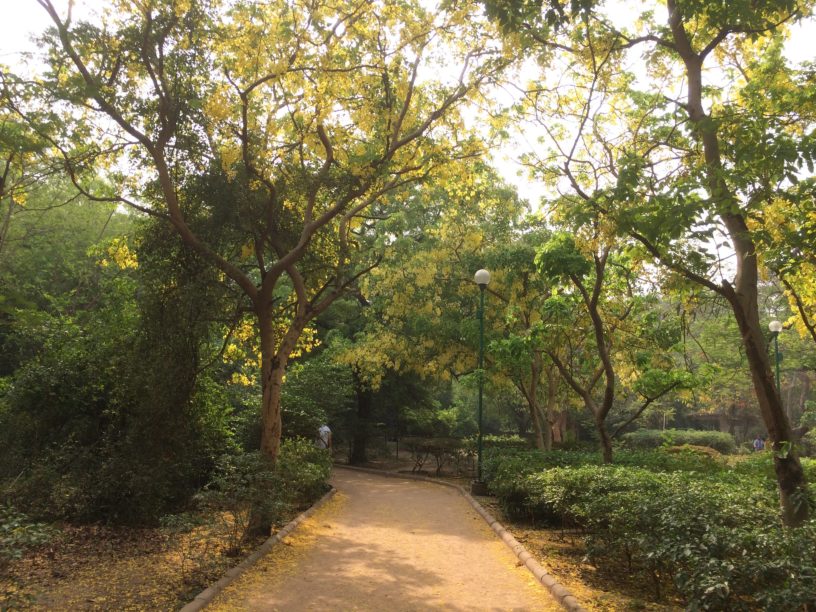
The dappled roads in the enclave were broad enough for three cars to cruise through at a time. After sunset, there were barely any people on the roads, giving the place a haunted, vulnerable feeling. Scrawny boys in big, expensive cars would drive to this shell of a place to park and smoke weed. The adjoining Siri Fort forest, tranquil and lovely in daylight, would become dark and scary, with stray overfed dogs going crazy at everyone.
I commuted to work on the Yellow Line of the Delhi metro, past stops like Race Course (now Lok Kalyan Marg), Green Park and Hauz Khas, in trains full of rich people drawling into the latest iPhones and carrying shopping bags from H&M and Muji. There was a breezy air of familiarity with the “foreign”. Aunties traveling with their daughters who just wanted to “see” and “experience” Delhi metro rides. Well-off people headed to Chandni Chowk for some “shaadi shopping”.
Whenever I told people that I lived in Panchsheel, they would give me a puzzled look. How could someone as young as me afford to live there?
In time I began to get a feel for the casually cool version of the language, the unspoken power relations and kinship patterns, and my own glaring oddity in this part of the city. It grew easier to talk to the guards, the vegetable and fruit vendors, thedrivers and the nariyal pani vendors in this exclusive, monotonous, suffocating community.
These people had the clothes, the moves, the music, the cars and most importantly the money. Overheard conversations were unenlightening, all about brands, pubs and cafés and restaurants, never rising above platitudes. So, when my boyfriend suggested I move to a place closer to his, in an opposite part of the city, I didn’t think twice.

In east Delhi, I felt a sense of danger right at the outset. Mayur Vihar is an unglamorous but vital part of the city, full of “essential workers”—drivers, ear cleaners, working-class autodidacts, cooks, locksmiths, typesetters, grocery clerks, carpenters, apprentices of all kinds, peasants and failed engineers. The teeming human activity here made me feel shamefully naïve, sheltered as I have been from the extremes of poverty and inequality.
Mayur Vihar shares a border with Noida, part of the state of Uttar Pradesh, notorious for its climbing rate of crimes in general, and those against women in particular. This would deeply affect my day-to-day life. Now I would be depending more on the Blue Line of the Delhi Metro, whose travelers seemed mostly weary-looking older people who wore the same shades of blue, black and grey to work every day at jobs that didn’t pay enough, and they were always on their phones. A big contrast from the Yellow Line’s starry-eyed, colorfully dressed passengers, chirpy and self-satisfied.
My walks, now, were limited to the main gate of my neighborhood and back; there was no more serendipity or exploring. Roadside chai and second-hand bookstalls replaced the cafés and restaurants of my old neighborhood. Boys played cricket on the lawns and girls cycled around on the concrete. I missed visiting the mall, where we could go unwind, order pizza and see a movie. Now these things meant travel to South Delhi. The trip would be about 45 minutes by taxicab, costing somewhere around INR 200-300 each way.
There was a sense of bonhomie in Mayur Vihar akin to that in my mother’s village, cozy and intimate. Within a month or two I recognized most of the vegetable vendors, autorickshaw and cycle rickshaw drivers. At the grocery store across the road, they would guess and ready some items on my list as I arrived. When I couldn’t get a particular herb or a sauce, an attentive clerk would take down my requests and promise to stock up the next time.
In that airy, huge house, where we lived with very sparse furnishings, we hosted the grandest of winter house parties. Come Friday night, our place would be crowded with the jolly company of lawyer and journalist friends, our mirth and sorrows melding together over Old Monk and Kerala cuisine. The drunken discourse would go on till wee hours when we would, just like in my mother’s village, all arrange the mattresses and quilts for our guests in our only heated room. The lack of central heating would hit us in the mornings, when we’d feel the pain of leaving the warm quilts to prepare tea and coffee. Those soirees concluded only after a sumptuous breakfast at Tamil Nadu Bhawan and a drive back home.
Happily for my boyfriend’s and my love for Carnatic food, we found a small Udupi restaurant near our house. During late evening strolls, we would munch on jhal muri (a puffed rice snack) and sip on hot made-to-order chai on the roadside. We’d walk in the dark, unlit lanes, often seeing fellow journalists who were staying nearby. In these small ways I made that side of Delhi my own, I created a nest with love, though in the knowledge that we would leave this place soon.
Mayur Vihar made me better understand the all-pervading cynicism underpinning this country, and what it lacks. It’s the kind of place where so much is happening all the time, but it rarely finds mention in a movie or a song.
I remember watching Roma on a gloomy, smoggy winter afternoon when I had called in sick at work. I saw the movie in one go and decided to go for a stroll and have a cup of chai from the nearest stall. I wrapped up in my mother’s old shawl and headed out. The stall was makeshift, ramshackle, and I felt a nervous apprehension build up inside as I waited. The old man behind the stove handed me a chipped off-white porcelain cup; the first sip in, I felt a watery tastelessness to it. I dumped it in the dustbin nearby, hastily handed the man his money and scooted back indoors.
In time I started convincing my boyfriend to move to the southern, cozier, familiar part of the city.
On reflection, I came to realize that Panchsheel Enclave was a place where people did not seem to like doing anything. These were moneyed families who didn’t hide the fact that they and their children didn’t need to work; the women seemed devoid of the desire to have a career or a job.
Mayur Vihar by contrast was a place where people with jobs lived. The everyday rush of Mayur Vihar, economically and socially more open than most other parts of the city, was almost unsettling in its chaotic activity. Malayalees, Tamilians, Mahrashtrians, people from Punjab, West Bengal, Uttar Pradesh and Bihar—east Delhi was, in fact, more cosmopolitan than most other parts of the Capital.
As Panchsheel had maintained its quiet pace, Mayur Vihar had in effect kept with the times; home to a diverse blend of residents, including white-collar professionals and senior journalists, that is quite rare in all of north India. With its narrow dingy lanes, troublesome traffic issues, lack of gardens, spaced out parking lots and brilliant Metro connectivity, it was a burgeoning area that was going to remain so for decades to come. And this is just what I did not like. I wanted to live in a place that didn’t look like the place where I grew up.
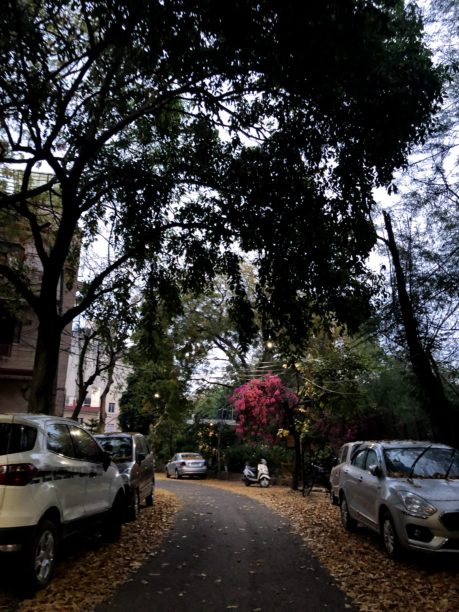
In June last year, we moved to the south-east corner of Delhi. Chittaranjan Park or CR Park, as it is known, is an all-Bengali neighborhood in south-east Delhi. With its ample parks and cozy zig-zag lanes, this area affords to me, an avid walker and ambler, more comfort than my previous two homes. With its quirky addas (impromptu junctions where Bengali people discuss politics and sport) and numerous markets, its buzzing aliveness, the area had a lot going for me.
We found a snug top floor two-bedroom flat. Most of the houses here had basements converted to offices for lawyers and chartered accountants, or to warehouses. There was an eclectic mix of residents, artistic-looking people, the odd girl walking her poodle at four in the morning and a middle-aged couple who’d go for an evening stroll every evening at 5:00.

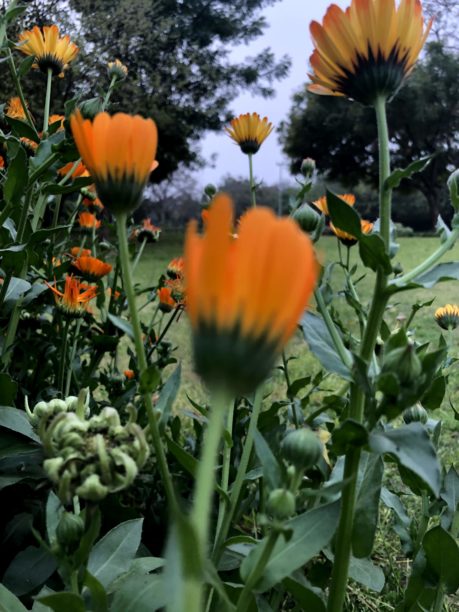
The neighborhood with its greenery and rich cultural background has the vibe of a place where intellectuals, artists, activists, thinkers and the middle class have long gathered to socialize, entertain and inspire each other.
A wealth of trees, from Ashok to Kadamb to the more regular Delhi trees like the Gulmohar and Amaltas adorn the narrow roads here, and there are public street gardens, providing a natural habitat for street cats that lend the neighborhood an aura of intimacy. In the evenings, most doors open, or the chiks roll up, and the orange glow of warm evening lights spills onto balconies.
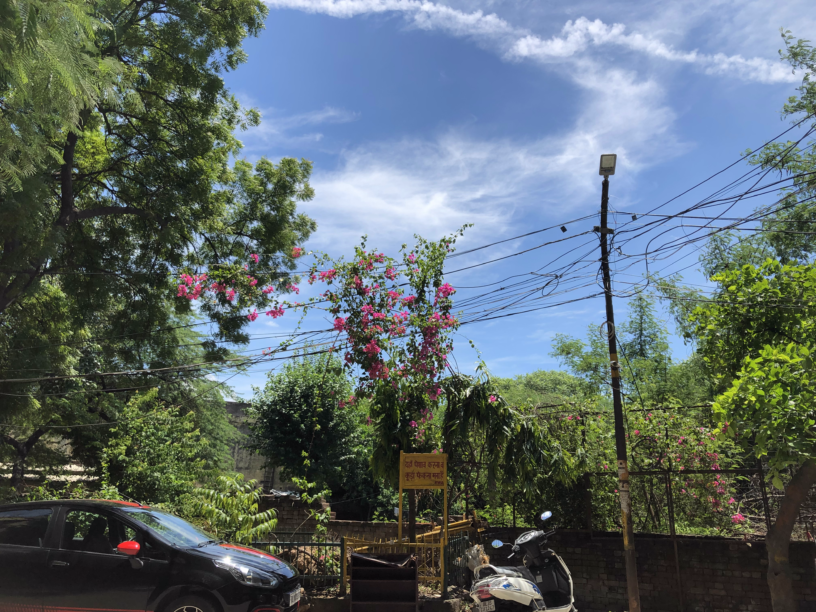
With the diversity of this neighborhood and its residents, its tree-lined roads, and dappled balconies, CR Park was the perfect, quiet and comfortable place to spend our locked-in days, that would wear into weeks and months. The place feels so lived-in, labyrinthine, fantastical, mythical and believable all at once, that spending quarantine here has somehow not driven us up the walls. I have actively tried to resist losing myself in screengazing, and instead have devoted myself to walking and discovery, finding solace and meaning in even the smallest, most mundane details.
Though I resisted the lure of Delhi, though I never meant to come here, I have slowly given in to this place, absorbing, moment by moment, the life I am really living and not the one I might have dreamed of as a younger woman. Panchsheel Enclave emboldened the values I had long nurtured growing up; Mayur Vihar taught me patience and consciousness of the broad range of ways in which we live. I gave way to the city at last during the lockdown, when the refreshing and diverse outlook of CR Park helped strengthen my roots in a city far beyond my childhood dreams. Delhi finally began to have a semblance of home as I gathered these experiences and came to an acceptance, which was at once thrilling and frightening, of the insistent reality of my place in the larger world and among the people in it.

